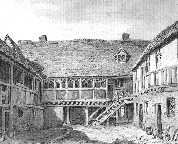|
The present George Street was
known as Church Street because it led, via
Romeland, to the church, not only the Abbey Church
itself but also the parish church of St. Andrew -
St. Andrews Chapel - situated against the north
west corner of the nave of the Abbey church. There
was a marked difference available for development
on either side of the street. On the south the
properties backed onto the precinct wall of the
Abbey and by the second half of the 14th century
encroachment onto the Abbey had become so bad that
Abbot Thomas de la Mere employed the royal mason
Henry Yevele to carry out a survey of the problem.
The old stone wall was replaced by an "earth wall"
i.e.. a bank. On the other side of the street the
properties at the western end backed onto Dagnall
Street and at the eastern end upto those stretching
back from French Row. This difference accounts for
the development of inns, which needed space for the
yard and services on this northern side, while on
the southern shops developed. Among those who held
property recorded in the Yevele's survey was
Richard Wallingford, sometime bailiff of the town
and one of the leaders of the 1381 Revolt.
In 1431 the street was leveled and drained by
William Bakere using beech wood taken from
Eywood.
|
In 1235-60 Abbot
John de Hertford "acquire a great house
in a street called "Chirche Strate' very
suitable for guests, .........it is a
corner house and common to the street
which runs towards the east and that which
goes to the north, it is before the Abbey
Gate." This was the corner with Spicer
Street where in later times the inn known
as the Tabard (so called in 1545) was
situated. This is the earliest inn
recorded in St. Albans . These came into
being in the 12th century and by the
14-15th. century were a popular way of
reducing the ever increasing cost of
hospitality borne by monasteries. Much of
this inn was demolished in the 19th
century but part remains in the shop
bearing the old name. A 19th century
illustration shows the view from the rear
of the street showing a gallery of
14th-15th century date.
|

The
Tabard in the early 19th
century
|
These were perhaps both built
around 1500 and have overhanging (jettied)
upper storeys.
|